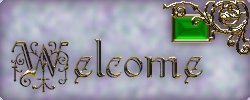Please, see the Terms of Usage on the Sets page for use of graphics. Tutorials may not be reproduced without express written permission of the author.


Simple Faceted Gems

In this tutorial, we will use Paint Shop Pro 5 and Blade Pro to do the following:
- On the first page, we will create "gems" with fairly simple facets, but clearly distinguishable pavilion cuts. Masters can be saved and the "type" of gem (i.e. color) changed as needed. Two masters are available for download at the end of this tutorial. This section requires Blade Pro to make your own masters, but just PSP if you download mine.
- On the second page, we will explore how to create the texture found on this set in both a light and dark version. This will employ the use of the "hue map". (Added 09/30/98)
- On the third page, we will look at ways of using Blade Pro to make metallic decorations from very "thin" dingbats, such as some of Davy's Dingbats. (Added 09/09/98)

| Step 1 | Open a new image. I used 100 x 100 with a white background. |
| Step 2 | Add a new layer called "Pavilion". |
| Step 3 | Use the rectangular selection tool to select a nicely proportioned rectangle. Flood fill this with white and save the selection to the alpha channel, calling it "Gem". |
| Step 4 | Duplicate this layer and call it "Crown". |
| Step 5 | Go to the Pavilion layer and apply the "juh-gem-pavilion.q9q" Blade Pro preset. See Note 1.
It should look like the following:
|
| Step 6 | Now, go to the Crown layer and apply the "juh-gem-crown.q9q" Blade Pro preset. See Note 1.
It should look like the following:
|
| Step 7 | Do a select none, and then use the eyedropper to pick up the color of the flat face. This is called the table facet. Use the magic wand with a tolerance of 25 to select the table facet. See Note 2. Promote this selection to a new layer called "Table". Save the selection to the alpha channel as "Table Facet". |
| Step 8 | Go back to the Crown layer and delete the selection. That gets rid of the table facet on that layer. |
| Step 9 | Add another layer on top of the Crown layer and call it "Color". Change the blend mode of this layer to "Hard Light". See Note 3. Load the Gem selection from the alpha channel and flood fill it with the color of your choice. For the emerald, I used HSL = (85,255,64). |
| Step 10 | Begin to play with the opacity sliders to get the desired effect.
The following are the settings I used for my emerald:
|
| Step 11 | If desired, you can put a little setting or frame around your gem. Create a new layer to do this on. See the previous tutorial for some techniques. |
| Note 1 |  The
Blade Pro settings used to create the emerald are part of the "vs_faceted_gems.zip"
file available for download. When applying these settings to the octagonal shape
of the amethyst, they need to be modified. This may even be true of a rectangle of
different size or proportion. The most important parameters to vary include the
radius, height, and the color and direction of the two source lights. You may also
want to manipulate the glare, caustic, etc. There is no way for me to lay out a
recipe for this. It must be done by trial and error. The
Blade Pro settings used to create the emerald are part of the "vs_faceted_gems.zip"
file available for download. When applying these settings to the octagonal shape
of the amethyst, they need to be modified. This may even be true of a rectangle of
different size or proportion. The most important parameters to vary include the
radius, height, and the color and direction of the two source lights. You may also
want to manipulate the glare, caustic, etc. There is no way for me to lay out a
recipe for this. It must be done by trial and error. |
| Note 2 |  An
alternative to the magic wand approach is to simply select the table facet using the
rectangular selection tool. An
alternative to the magic wand approach is to simply select the table facet using the
rectangular selection tool. |
| Note 3 |  You
may want to try other blend modes for the Color layer. For the amethyst, I used
Overlay. You
may want to try other blend modes for the Color layer. For the amethyst, I used
Overlay. |
| Note 4 |  The raised effect for
the welcome, bar, buttons, etc. is taken from the first part of Mardi's tutorial on Jeweled
Graphics. The raised effect for
the welcome, bar, buttons, etc. is taken from the first part of Mardi's tutorial on Jeweled
Graphics. |
 Here is the link to the zip file
for presets and gem masters.
Here is the link to the zip file
for presets and gem masters. |

